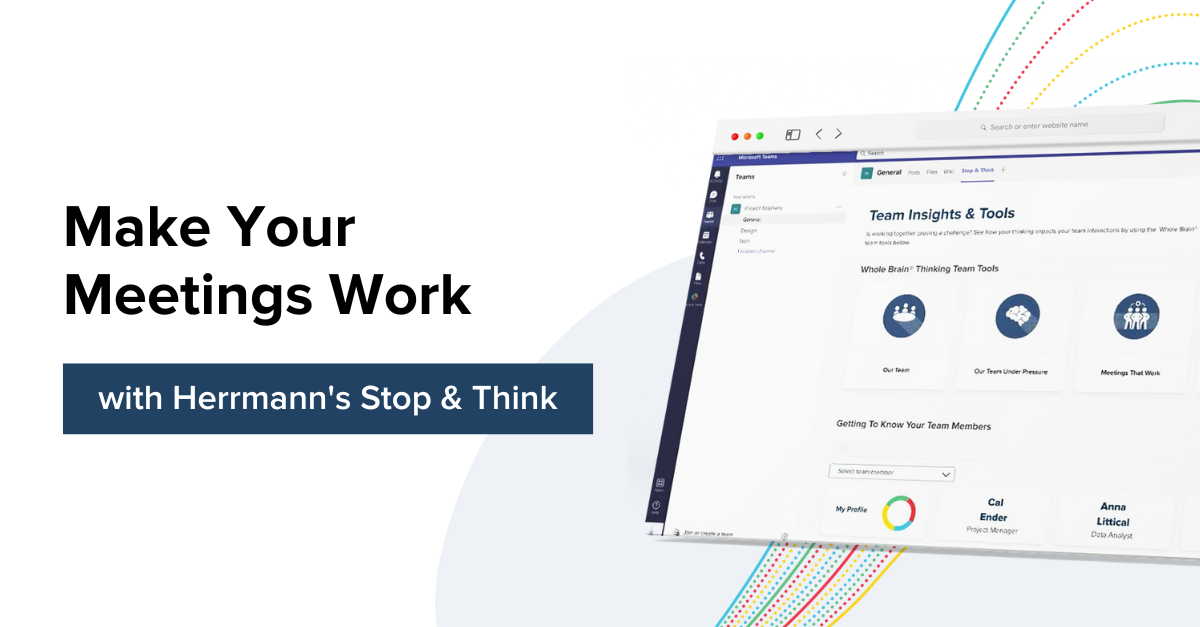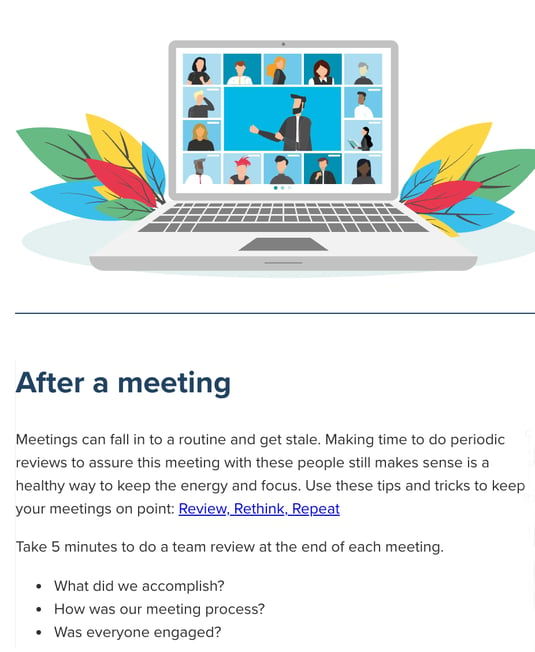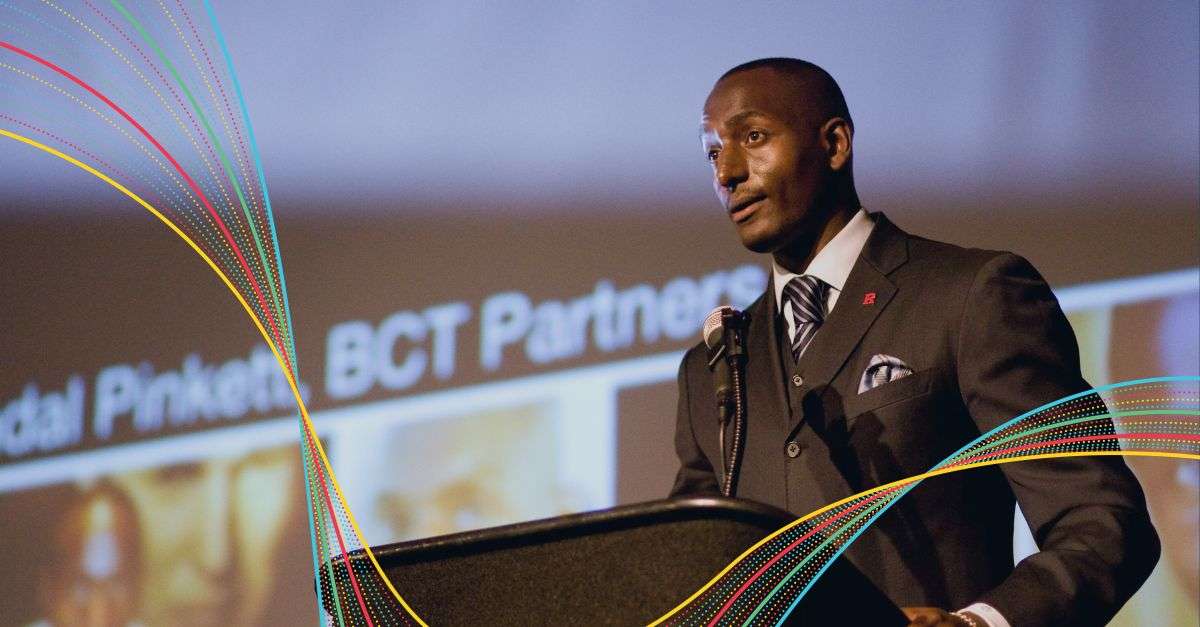For most of my professional life, I’ve worked with software product development teams, as a business analyst and product manager. That means I get to collaborate with several different people to accomplish anything.
As a result, I’ve built a love-hate relationship with meetings:
I love meetings when they help my team build products and customers solve problems.
I’m not a fan of meetings that don’t make progress toward those outcomes, which seem to be most of them.
I suspect a lot of you can relate, so here are some thoughts on meetings, why they’re important, what challenges they present, and how you can make your meetings work with the help of Herrmann’s Stop & Think app in Microsoft Teams.
Why Meetings Still Matter
These days, whether people are back in the office, remote, or hybrid, organizations accomplish a great deal through the work of teams - and one of the primary tools that teams use to communicate is the meeting.
Teams use meetings to gather, exchange ideas, share feedback, and learn from each other. When structured and run correctly, they can help team members:
- Build strong relationships with each other
- Make informed decisions and get aligned on those decisions
- Feel included and engaged in the team
- Advance their creative thinking and innovation
- Share feedback and identify opportunities for continuous improvement
With all of those benefits, it’s tempting to believe that the more meetings you have, the better. Unfortunately, that’s not necessarily the case.
Why Meetings Can Be Challenging
The one big glaring downside to meetings is that they take time away from other tasks directly related to people’s jobs. To be fully present in a meeting, you can’t really multi-task, which creates a very real constraint when a calendar is jam-packed with meetings. How many times have you felt there’s not enough time in the workday to tackle all the tasks generated in your back-to-back meetings?
There’s a variety of reasons meetings can appear to be a waste of time:
- Unclear goals for gathering
- Lack of an agenda
- No action items or plans for follow-up
- Not staying on track
A poorly designed or facilitated meeting is often worse than no meeting at all and can lead to a lack of engagement from team members.
We’ve all heard the saying, “this meeting could have been an email,” and it’s usually not far off the mark in an increasingly virtual work world. Some meetings don’t need to happen at all because there’s another asynchronous form of communication better suited to the goal that allows people to engage when it’s most convenient or relevant.
If the reason for a meeting is one-way communication of information, there are often better ways for a team to spend their time.
Sign up to our newsletter for the latest insights
Then there are cases where a meeting is the right form of communication, and the right people are involved, but it’s not planned and led effectively. In these cases, meetings tend to go longer than they need and still don’t accomplish their intended outcomes. In those cases, the meeting might feel like a waste.
At the same time, there are completely valid reasons to meet live — like when a team needs some real-time interactive engagement, such as collaborative brainstorming, building trust, making a decision, or planning their upcoming projects. The question then becomes, if we have to meet, how can we make it work for everyone involved?
How to make a meeting work
If you want to make a meeting work, make sure it’s the right form of team engagement, include the right people, and facilitate the meeting so that you accomplish what you set out to accomplish.
Fortunately, Whole Brain® Thinking and the Stop & Think app in Microsoft Teams can provide help in a variety of areas to make sure the meetings you have are meetings that work.
Plan a Meeting
Your first chance to ensure an effective meeting comes when you plan it — a step all too often overlooked or skipped for expediency.
Before you fire up your organization’s calendar app of choice and see when everyone’s available, put some thought into what you hope to accomplish and whether a meeting is the best way to do that.
Here are some guidelines for deciding whether a meeting is the best choice of communication:
If the task you need to accomplish requires real-time engagement between multiple team members and you have an urgent need to produce a result together, a meeting is probably your best bet.
If you’d like to have two-way communication, but that communication doesn’t have to happen simultaneously, use a collaboration tool such as Teams or Slack and avoid the meeting. These collaboration tools have the added benefit of making the dialog available to the entire team. Regular status updates within the team are a good example of this form of communication.
If you’re sharing information and don’t need a response, especially with an external audience, use email for this type of communication. Routine status updates outside an internal team and FYIs are prime examples of this form of communication.
When you decide a meeting is called for, next think about who needs to be included. When you’re deciding who to invite, consider who has the knowledge and experience you need to accomplish what it is you hope to accomplish.
Now that you know you should have a meeting and who to invite, you can use guidance from The Meetings That Work section of Stop & Think to pull together a winning plan for your meeting.
The Plan a meeting portion of the Meetings That Work sliding carousel provides links to a set of resources that will help you (see image below):
- Identify potential frustrations and figure out what you can do to address them. This helps you think beyond what you want to accomplish in the meeting and consider others’ expectations and what they plan to accomplish.
- Consider the thinking preferences of your attendee list. If you create a meeting in the Microsoft Teams app and add Stop & Think to the meeting, it will automatically create team thinking maps and preference codes for everyone on the meeting invitation!
- Craft your agenda to get the most out of the people who attend.
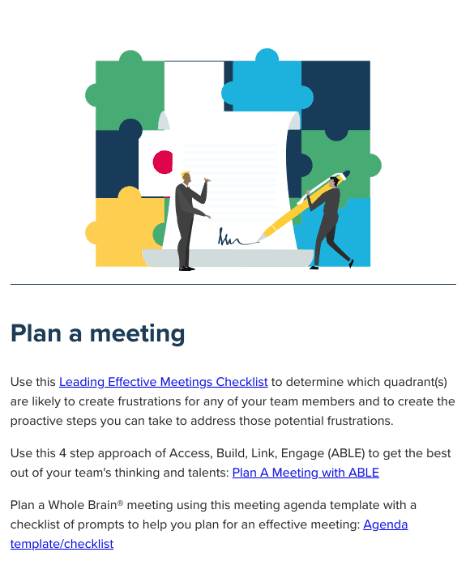
Leading Your Meeting
Choosing the proper communication approach for a scenario and including the right people is only half the battle.
Once the meeting starts, you need to follow a facilitation approach that drives toward accomplishing your desired outcome and makes use of the diverse thinking preferences you pulled together.
The Leading a meeting portion of the Meetings That Work sliding carousel (see image below) provides tips to help you build your facilitation approach and some questions to consider as you run your meeting.
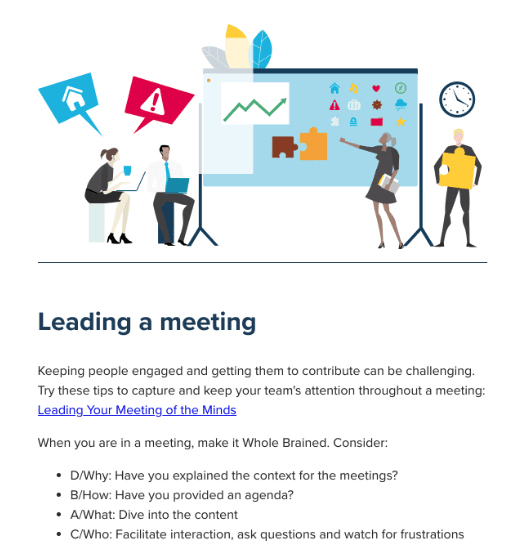
Keep Everyone Engaged in the Meeting
Knowing how you're going to facilitate a meeting when you go into it is always a good idea, but chances are you’re going to have to adapt your approach during the meeting to adjust to how people react to the discussion.
Often you’ll need to make adjustments in order to keep people engaged. The key to engagement is to make sure you include all the voices. Understanding everyone’s thinking preferences can help with that.
The Engagement ideas during a meeting portion of the Meetings That Work sliding carousel (see image below) provides some suggestions for how you can keep people engaged in your meetings, including downloadable activities to try during the meeting.
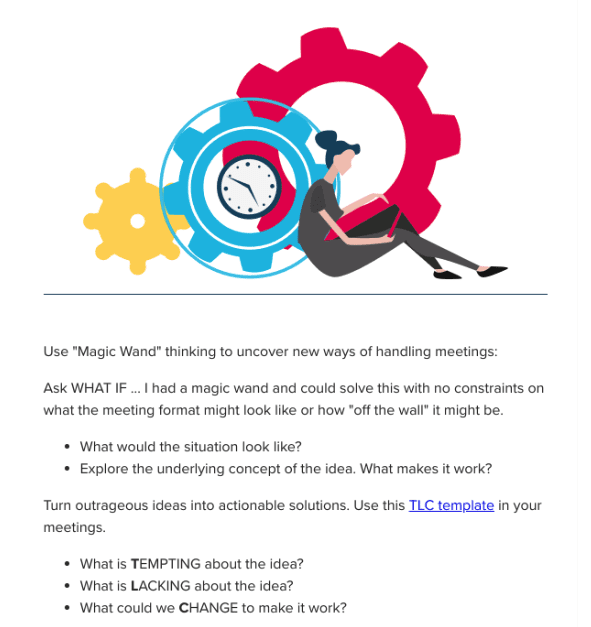
Follow Up After the Meeting
When you’re done with a meeting, it’s always a good idea to review how things went to make sure that you continue to have worthwhile meetings.
Your team will appreciate the fact that you make an effort to learn from past meetings and improve your approach in subsequent gatherings. There are few things more frustrating than repeating the same mistake - especially when it takes time away from other tasks.
The After a meeting portion of the Meetings That Work sliding carousel (see image below) suggests a retrospective approach that helps you look back at your meetings, identify what you learned from them, and make adjustments.
Make your next meeting work
Meetings can be a powerful tool that helps your team accomplish great things.
Or, they can become a barrier to your team working on the things that truly matter.
How you plan and lead meetings will go a long way in determining whether your meetings are a tool or a barrier.
Fortunately, Whole Brain® Thinking helps you make the most out of your meetings. Fire up the Stop & Think app in Microsoft Teams today to plan, lead, and debrief meetings that work.


